Numerical simulation of particle consolidation under compression and shear based on the Discrete Element method
IF 4.2
2区 工程技术
Q2 ENGINEERING, CHEMICAL
引用次数: 0
Abstract
This study introduces a three-dimensional (3D) Discrete Element Method (DEM) model designed to simulate particle consolidation under simultaneous compression and shear forces. The model is validated against experimental data for pure compression scenarios. Simulations involving simultaneous compression and shear are conducted to understand the impact of varying shear-to-compression ratios on particle consolidation. High shear-to-compression ratios lead to denser particle clusters, showing that shear promotes increased solid volume fractions. Additionally, the study explores the influence of different particle–particle interaction models, specifically the Derjaguin-Muller-Toporov (DMT) and Johnson-Kendall-Roberts (JKR) models. The results indicate that the DMT model generally leads to denser, more compact aggregates, whereas the JKR model tends to produce aggregates with a more elongated structure. Different agglomeration patterns were also found, which were classified as ‘shear-dominated’, ‘plateau’ and ‘compression-dominated’.

基于离散元素法的压缩和剪切作用下颗粒固结的数值模拟
本研究介绍了一种三维(3D)离散元素法(DEM)模型,旨在模拟压缩力和剪切力同时作用下的颗粒固结。该模型根据纯压缩情况下的实验数据进行了验证。同时进行压缩和剪切模拟,以了解不同的剪切压缩比对颗粒固结的影响。高剪切压缩比会导致颗粒簇更加致密,这表明剪切会促进固体体积分数的增加。此外,研究还探讨了不同颗粒-颗粒相互作用模型的影响,特别是 Derjaguin-Muller-Toporov 模型(DMT)和 Johnson-Kendall-Roberts 模型(JKR)。结果表明,DMT 模型通常会产生密度更大、更紧凑的聚集体,而 JKR 模型则倾向于产生结构更细长的聚集体。此外,还发现了不同的聚集模式,可分为 "剪切主导型"、"高原型 "和 "压缩主导型"。
本文章由计算机程序翻译,如有差异,请以英文原文为准。
求助全文
约1分钟内获得全文
求助全文
来源期刊

Advanced Powder Technology
工程技术-工程:化工
CiteScore
9.50
自引率
7.70%
发文量
424
审稿时长
55 days
期刊介绍:
The aim of Advanced Powder Technology is to meet the demand for an international journal that integrates all aspects of science and technology research on powder and particulate materials. The journal fulfills this purpose by publishing original research papers, rapid communications, reviews, and translated articles by prominent researchers worldwide.
The editorial work of Advanced Powder Technology, which was founded as the International Journal of the Society of Powder Technology, Japan, is now shared by distinguished board members, who operate in a unique framework designed to respond to the increasing global demand for articles on not only powder and particles, but also on various materials produced from them.
Advanced Powder Technology covers various areas, but a discussion of powder and particles is required in articles. Topics include: Production of powder and particulate materials in gases and liquids(nanoparticles, fine ceramics, pharmaceuticals, novel functional materials, etc.); Aerosol and colloidal processing; Powder and particle characterization; Dynamics and phenomena; Calculation and simulation (CFD, DEM, Monte Carlo method, population balance, etc.); Measurement and control of powder processes; Particle modification; Comminution; Powder handling and operations (storage, transport, granulation, separation, fluidization, etc.)
 求助内容:
求助内容: 应助结果提醒方式:
应助结果提醒方式:


